50 years ago today, on 7th December 1967, the very first Apple store opened its doors - The Beatles Apple Boutique. Situated on the corner of Baker Street and Paddington Street, London, the boutique was only short lived, lasting a little under 8 months, before its closure in July 1968 - however, it still managed to make its mark in history.
"Clive Epstein [Brian Epstein's brother] or some other such business freak came up to us and said, 'You got to spend so much money or the tax'll take it. We're thinking of opening a chain of retail clothes,' or some barmy thing like that. And we were all muttering about, 'Well, if we're going to have to open a shop, let's open something we're interested in.' We went through all these different ideas about this, that and the other. Paul had a nice idea about opening up white houses where it would sell white china and things like that, everything white because you can never get anything white, which is pretty groovy. It didn't end up with that, it ended up with Apple, with all this junk and The Fool and all the stupid clothes and all that."
[John Lennon, 1970, Lennon Remembers, Jann S Wenner]
Apple Boutique was one of the first business ventures undertaken by the Beatles new company, Apple Corps. The original concept for the shop was that everything was for sale, with Paul McCartney declaring it, "A beautiful place where beautiful people can buy beautiful things". The original plan was for the shop to sell a wide range of clothing, furniture, jewellery and art. John Lennon vetoed the use of the word 'Boutique' for this reason but in practice, the shop sold mostly clothing and accessories and became known as 'Apple Boutique'.
"It was silly, but we had wanted to open a shop and dress everyone like us."
[Ringo Starr, Beatles Anthology]
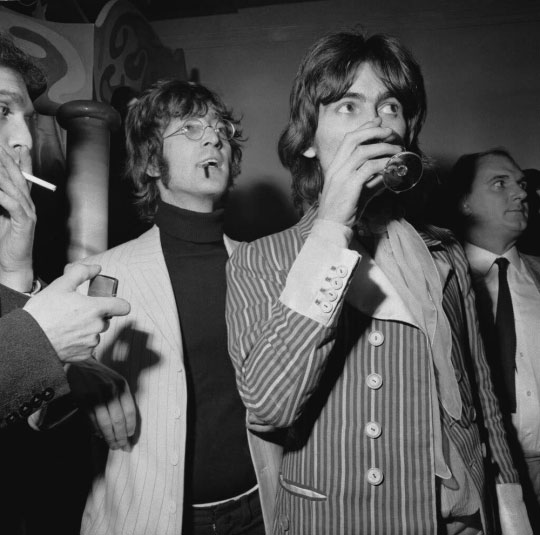
An opening party was held on the 5th December 1967, attended by John Lennon and George Harrison who are photographed watching the Apple Boutique fashion show above. George is sipping apple juice as the shop didn't have an alcohol licence. Other party guests including Eric Clapton, Jack Bruce and Cilla Black.
"The upstairs of Apple was filled with Indian posters of gods and goddesses, incense, bells, and anything else that was affordable and from the East. Down the creaky wooden stairs customers were greeted by a splash of colour, with every kind of garment hanging on rails in rows across the floor."
[Jenny Boyd, thejennyboyd.com, 2nd December 2017]
However, Apple Boutique immediately caught media attention for an entirely different reason. The Fool was the collective name for Dutch designers, Simon Posthuma and Marijke Koeger along with artist Josje Leeger. Later Simon Hayes and Barry Finch who ran a public relations company in London became part of The Fool. They were commissioned by The Beatles to design the stock and look of Apple Boutique, for what was intended to be a chain of shops across the UK. The Beatles were already fans of The Fool's work, with George commissioning them to paint psychedelic inspired murals on his Mini car and fireplace at his home, Kinfauns and both John and Paul having pianos painted in similar styles.
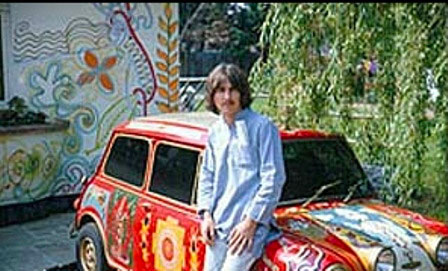
Inspired by the mural on the Lord John shop on Carnaby Street, The Fool set about designing and painting a mural to cover the entirety of the building's facades. The Beatles took a lease out on a Georgian town house, 94 Baker Street, in the Marylebone area of London - quite a distance from the famous fashion districts of the time, Carnaby Street and Kings Road.
"The Apple shop stood on the corner of Baker Street and Paddington Street, and a month before it opened The Fool and some students painted an enormous mural on the outside wall. A swathe of every colour from the rainbow; planets and stars, swept across the front and side of the building from the ground up to the fourth floor, including the chimney. Nothing like this had ever been seen before! It was shocking and wonderful and attracted all kinds of people to stop and peer through the window. Baker Street, up until this point, was basically 19th century conservative and the only thing it was famous for was the Sherlock Holmes Museum."
[Jenny Boyd, thejennyboyd.com, 2nd December 2017]
The mural was painted by The Fool and a team of art students between 10th and 12th November 1967, but they ran into controversy straight away. Westminster City Council had not granted permission for the mural, (and it was argued the mural constituted advertising for which a licence had to be issued), and nor had the building's landlord given permission for it to be painted.
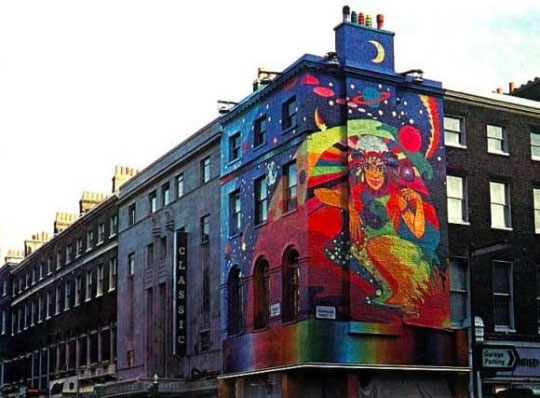
The mural also attracted complaints from local traders and eventually the council issued Apple with an enforcement notice to paint it over. It was finally painted over in May 1968, obliterated with white paint, and the word 'Apple' was added in cursive script on each fascia.
"If they'd protected it and the painted wall was there now, they would be saying, 'Wow, look at this. We've got to stop it chipping off.' But that's just typical of the narrow minds we were trying to fight against. That's what the whole Sixties Flower-Power thing was about: 'Go away, you bunch of boring people.' The whole government, the police, the public—everybody was so boring, and then suddenly people realised they could have fun.
[George Harrison, Beatles Anthology]
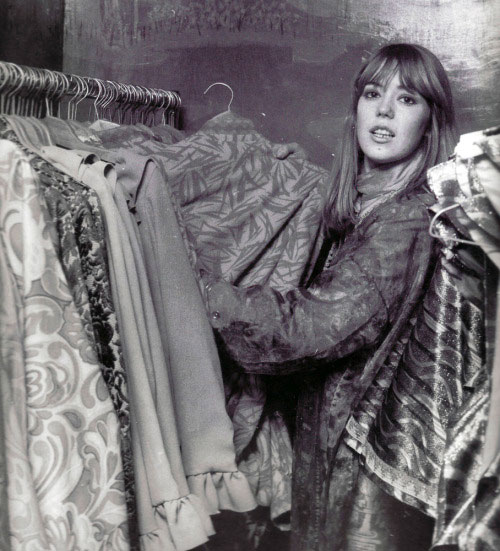
Jenny Boyd in the Apple Boutique.
Nonetheless, the shop had opened to the general public on the 7th December. Model, Jenny Boyd, (George Harrison's sister-in-law) worked as a shop assistant and it was managed by Pete Shotton, John Lennon's best friend from school.
The Fool also designed the clothing range stocked in the Apple Boutique. They'd previously designed clothing for the Beatles themselves, including the intricate styles worn in the I Am The Walrus promo film (although Ringo later complained his outfit was so heavy it made it difficult for him to play drums).
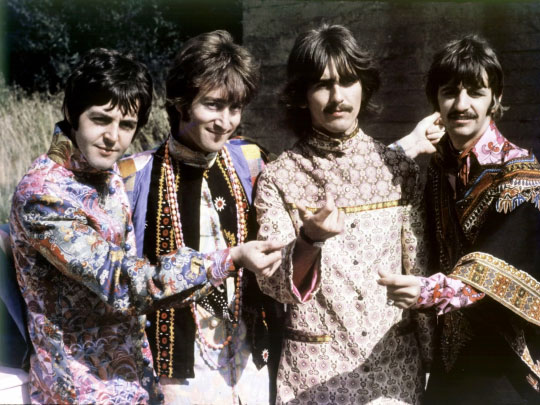
In similar veins, The Fool had free reign to design and make luxurious and intricate clothing, unique pieces often in expensive fabrics. The Fools beautiful, yet expensive, designs including crushed velvet jackets, mini dresses with optional long skirt attachments, coats made out of heavy tapestry and other dress and shirts that looked more suitable for costume parties than everyday wear.
Boys and girls can't go to offices dressed quite like we are. But we have made velvet suits for boys and dresses for girls that they could begin to wear everywhere."
[Marijke Koeger, 1967]
In the early days of the shop, The Fool accompanied by Pete Shotton spent ten days in Marrakesh in search of antiques and object d'art for the boutique. As an early indicator of how things would progress, they returned home with precious few items in hand. The remainder of their purchases were "lost in the post" at Apple's cost.
Simon Posthuma insisted all the labels for the garments be made from silk, resulting in some of the garment's labels costing more to produce than the actual garment itself. But when Pete Shotton raised this with John Lennon, he just replied, "We're not business freaks, we're artists," and The Fool continued designing their clothing.
In addition, Pete Shotton found it difficult to manage the demands and whims of the four Beatles, making the day-to-day running of the shop arduous.
"One morning, for instance, Paul came into the shop and told us where to install a partition. Almost as soon as we had done his bidding, John showed up, took a good look round, and said, 'What the f**k's going on in here? What's all this stuff up for?' 'Paul told us he wanted partitions up,' I explained. 'Oh, get the f**king lot out,' John ordered. 'I don't want these f**king stupid partitions in here!' The offending partitions were duly removed."
[Pete Shotton]
Unsurprisingly, the business lost money, and quickly - more than £200,000. Shoplifting is also blamed for some of the shops losses (this was refuted by Jenny Boyd however) and the fact that The Beatles, some of their friends, shop staff and particularly the designers themselves, would often take items from the shop without paying for them. The Apple Boutique closed on the 31st July 1968.
Once we were told we had to get rid of the painting, the whole thing started to lose its appeal. The whole tone of the events around the Apple shop was going sour, and - as it was not working out - we decided to sell it. We ended up giving the contents away. We put an ad in the paper and we filmed people coming in and grabbing everything.
[George Harrison, Beatles Anthology]
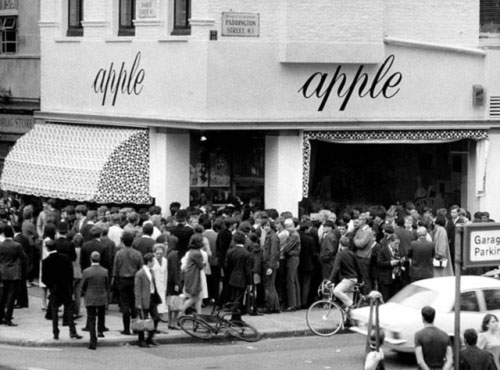
The night before the closure, the Beatles and their wives and girlfriends came to take the items they wanted from the shop. The day after it was announced that all the remaining stock would be given away for free, one item per customer. Within a few hours the shop was completely empty, including a lot of the fixtures and fittings. People came in such numbers that police presence was required.
"We decided to close down our Baker Street shop yesterday and instead of putting up a sign saying, 'Business will be resumed as soon as possible', and then auction off the goods, we decided to give them away. The shops were doing fine and making a nice profit on turnover. So far, the biggest loss is in giving the things away, but we did that deliberately. We're giving them away - rather than selling them to barrow boys - because we wanted to give rather than sell. [...]
"Our main business is entertainment - communication. Apple is mainly concerned with fun, not with frocks. We want to devote all our energies to records, films and our electronics adventures. We had to re-focus. We had to zoom in on what we really enjoy, and we enjoy being alive, and we enjoy being Beatles."
[From Paul McCartney's press release following the closure of the Apple Boutique]
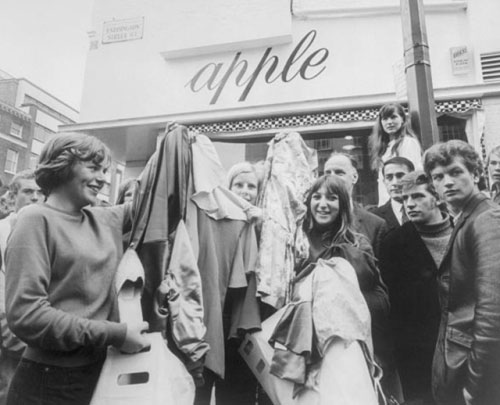
It was a big event and all the kids came and just took everything that was in the shop. That was the best thing about the whole shop, when we gave it all away. But the night before, we all went in and took what we wanted. It wasn't much, T-shirts... it was great, it was like robbing. We took everything we wanted home.
"And the next day we were watching, and there were thousands of kids all going in and getting their freebies. It was great. Of course, Derek [Taylor, Apple's press officer] and the others hated it but it so happened that I was running the office at that time, so we were in control. Paul had called me up one day and said, 'I'm going away. You take over.' It was as stupid as that."
[John Lennon, 1972]

